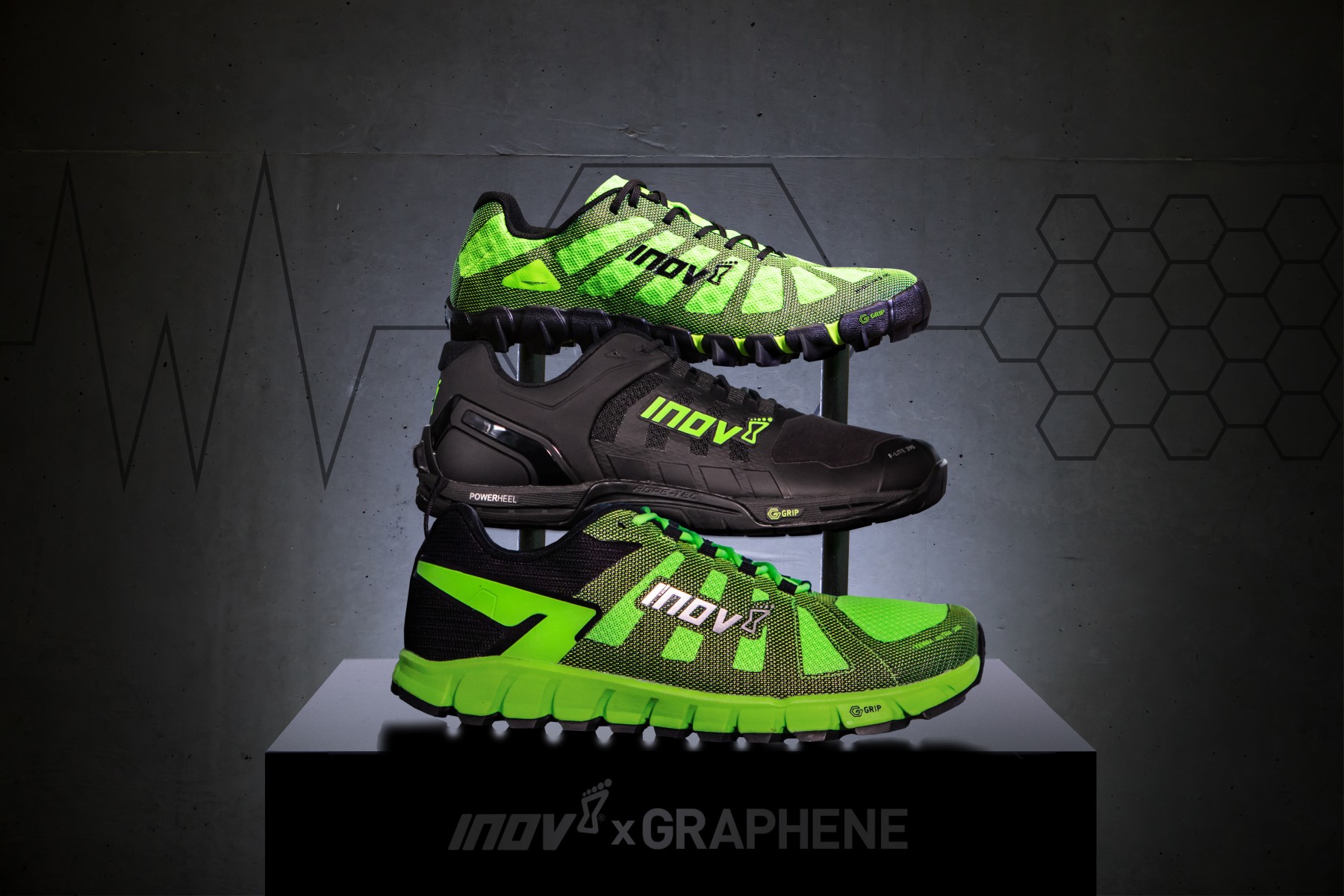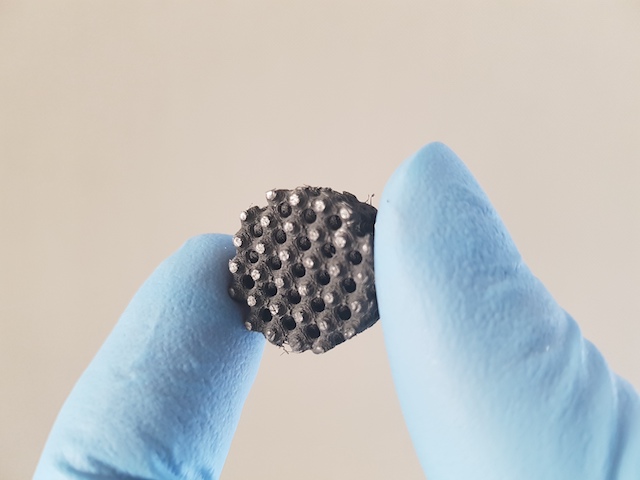Regardless of what these shoes are called, they contain, apparently, some graphene. As to why you as a consumer might find that important, here’s more from a June 20, 2018 news item on Nanowerk,
The world’s first-ever sports shoes to utilise graphene – the strongest material on the planet – have been unveiled by The University of Manchester and British brand inov-8.
Collaborating with graphene experts at National Graphene Institute, the brand has been able to develop a graphene-enhanced rubber. They have developed rubber outsoles for running and fitness shoes that in testing have outlasted 1,000 miles and are scientifically proven to be 50% harder wearing.
The National Graphene Institute (located at the UK’s University of Manchester) June 20, 2018 press release, which originated the news item, provides a few details, none of them particularly technical or scientific, no mention of studies, etc. (Note: Links have been removed),
Graphene is 200 times stronger than steel and at only a single atom thick it is the thinnest possible material, meaning it has many unique properties. inov-8 is the first brand in the world to use the superlative material in sports footwear, with its G-SERIES shoes available to pre-order from June 22nd [2018] ahead of going on sale from July 12th [2018].
The company first announced its intent to revolutionise the sports footwear industry in December last year. Six months of frenzied anticipation later, inov-8 has now removed all secrecy and let the world see these game-changing shoes.
Michael Price, inov-8 product and marketing director, said: “Over the last 18 months we have worked with the National Graphene Institute at The University of Manchester to bring the world’s toughest grip to the sports footwear market.
“Prior to this innovation, off-road runners and fitness athletes had to choose between a sticky rubber that works well in wet or sweaty conditions but wears down quicker and a harder rubber that is more durable but not quite as grippy. Through intensive research, hundreds of prototypes and thousands of hours of testing in both the field and laboratory, athletes now no longer need to compromise.”
Dr Aravind Vijayaraghavan, Reader in Nanomaterials at The University of Manchester, said: “Using graphene we have developed G-SERIES outsole rubbers that are scientifically tested to be 50% stronger, 50% more elastic and 50% harder wearing.
“We are delighted to put graphene on the shelves of 250 retail stores all over the world and make it accessible to everyone. Graphene is a versatile material with limitless potential and in coming years we expect to deliver graphene technologies in composites, coatings and sensors, many of which will further revolutionise sports products.”
The G-SERIES range is made up of three different shoes, each meticulously designed to meet the needs of athletes. THE MUDCLAW G 260 is for running over muddy mountains and obstacle courses, the TERRAULTRA G 260 for running long distances on hard-packed trails and the F-LITE G 290 for crossfitters working out in gyms. Each includes graphene-enhanced rubber outsoles and Kevlar – a material used in bulletproof vests – on the uppers.
Commenting on the patent-pending technology and the collaboration with The University of Manchester, inov-8 CEO Ian Bailey said: “This powerhouse forged in Northern England is going to take the world of sports footwear by storm. We’re combining science and innovation together with entrepreneurial speed and agility to go up against the major sports brands – and we’re going to win.
“We are at the forefront of a graphene sports footwear revolution and we’re not stopping at just rubber outsoles. This is a four-year innovation project which will see us incorporate graphene into 50% of our range and give us the potential to halve the weight of running/fitness shoes without compromising on performance or durability.”
Graphene is produced from graphite, which was first mined in the Lake District fells of Northern England more than 450 years ago. inov-8 too was forged in the same fells, albeit much more recently in 2003. The brand now trades in 68 countries worldwide.
The scientists who first isolated graphene from graphite were awarded the Nobel Prize in 2010. Building on their revolutionary work, a team of over 300 staff at The University of Manchester has pioneered projects into graphene-enhanced prototypes, from sports cars and medical devices to aeroplanes. Now the University can add graphene-enhanced sports footwear to its list of world-firsts.
…
A picture of the ‘shoes’ has been provided,

Courtesy: National Graphene Institute at University of Manchester
You can find the company inov-8 here. As for more information about their graphene-enhanced show, there’s this,from the company’s ‘graphene webpage‘,
1555Graphite was first mined in the Lake District fells of Northern England
2004Scientists at The University of Manchester isolate graphene from graphite.
2010The Nobel Prize is awarded to the scientists for their ground-breaking experiments with graphene.
2018inov-8 launch the first-ever sports footwear to utilise graphene, delivering the world’s toughest grip.
Ground-breaking technology
One atom thick carbon sheet
200 x stronger than steel
Thin, light, flexible, with limitless potential
inov-8 COLLABORATION WITH THE NATIONAL GRAPHENE INSTITUTE
Previously athletes had to choose between a sticky rubber that works well in wet or sweaty conditions but wears down quicker, and a harder rubber that is more durable but not quite as grippy. Through intensive research, hundreds of prototypes and thousands of hours of testing in both the field and laboratory, athletes now no longer need to compromise. The new rubber we have developed with the National Graphene Institute at The University of Manchester allows us to smash the limits of grip [sic]
The G-SERIES range is made up of three different shoes, each meticulously designed to meet the needs of athletes. Each includes graphene-enhanced rubber outsoles that deliver the world’s toughest grip and Kevlar – a material used in bulletproof vests – on the uppers.
Bulletproof material for running shoes?
As for Canadians eager to try out these shoes, you will likely have to go online or go to the US. Given how recently (June 19, 2018) this occurred, I’m mentioning the US president’s (Donald Trump) comments that Canadians are notorious for buying shoes in the US and smuggling them across the border back into Canada. (Revelatory information for Canadians everywhere.) His bizarre comments occasioned this explanatory June 19, 2018 article by Jordan Weissmann for Slate.com,
During a characteristically rambling address before the National Federation of Independent Businesses on Tuesday [June 19, 2018], Donald Trump darted off into an odd tangent in which he suggested that Canadians were smuggling shoes across the U.S. border in order to avoid their country’s high tariffs.
There was a story two days ago in a major newspaper talking about people living in Canada coming into the United States and smuggling things back into Canada because the tariffs are so massive. The tariffs to get common items back into Canada are so high that they have to smuggle ‘em in. They buy shoes, then they wear ‘em. They scuff ‘em up. They make ‘em sound old or look old. No, we’re treated horribly. [emphasis mine]
Anyone engaged in this alleged practice would be avoiding payment to the Canadian government. How this constitutes poor treatment of the US government and/or US retailers is a bit a of puzzler.
Getting back to Weissman and his article, he focuses on the source of the US president’s ‘information’.
As for graphene-enhanced ‘shoes’, I hope they are as advertized.

